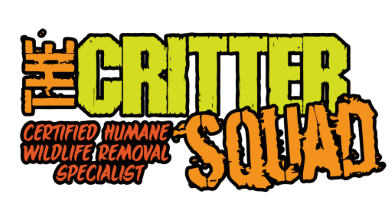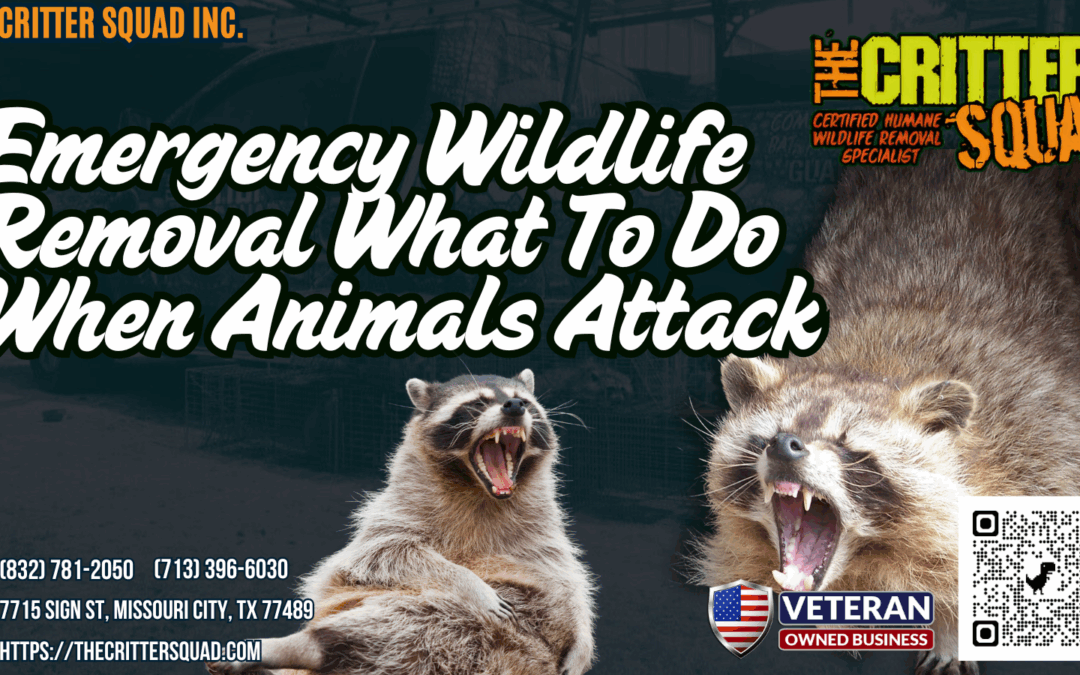Emergency wildlife removal is essential when animals display aggression towards humans. Individuals should remain calm and avoid direct eye contact, which can escalate the situation. Identifying escape routes and evaluating surroundings helps guarantee safety. If aggression persists, contacting professional wildlife services is advisable, as they possess expertise in safe animal removal and prevention strategies. Awareness of wildlife behaviors and risks associated with encounters is crucial, and further insights can enhance understanding of effective management techniques.
Key Article Highlights
- Remain calm and avoid sudden movements to prevent escalating the animal’s aggression during an encounter.
- Assess your surroundings for safe escape routes while keeping the animal in your peripheral vision.
- Do not make direct eye contact, as it may be perceived as a threat by the animal.
- If bitten, clean the wound immediately with soap and water, and apply a sterile bandage.
- Contact professional wildlife removal services if the animal poses a significant threat or shows aggressive behavior.
Understanding Common Wildlife Threats
What factors contribute to the increasing encounters between humans and wildlife? Urban expansion, climate change, and habitat destruction notably alter animal habitats, leading to increased interactions. As cities grow, wildlife is pushed into closer proximity with human populations, often resulting in altered wildlife behavior. Animals adapt to urban environments, seeking food and shelter in human-inhabited areas. This behavior can heighten the risk of conflict, as species such as raccoons, coyotes, and deer become more common in residential settings. Additionally, seasonal shifts and food scarcity can drive animals into urban areas, compounding potential threats. Understanding these dynamics is essential for communities aiming to mitigate risks and foster coexistence with local wildlife while promoting safety and preservation of natural ecosystems. Raccoons are known to be particularly drawn to food sources such as garbage cans and pet food left outdoors, which can significantly influence the likelihood of conflicts, as these adaptable creatures often scavenge for food in residential areas. Moreover, some wildlife, such as bats, can enter homes through small openings, leading to potential bat health risks for residents. Implementing humane raccoon trapping strategies can help manage raccoon populations without harming the animals or escalating conflicts.
Prevention Strategies to Avoid Wildlife Encounters
Although wildlife encounters can pose significant risks to both animals and humans, implementing effective prevention strategies can greatly reduce these interactions. By adopting proactive measures, individuals can create safer environments for all.
- Fencing Solutions: Installing robust fencing can deter animals from entering residential areas or gardens.
- Food Storage: Securely storing food in animal-proof containers minimizes attraction and accessibility for wildlife.
- Landscape Management: Keeping yards clean and free of debris reduces potential hiding spots for animals.
- Educating the Community: Raising awareness about wildlife behavior and safety precautions informs residents and fosters responsible interactions.
What to Do If You Encounter an Aggressive Animal
When encountering an aggressive animal, maintaining composure is essential to avoid escalating the situation. Individuals should remain calm and quiet, as sudden movements or loud noises may provoke further aggression. Backing away slowly can provide a safe distance while signaling to the animal that there is no immediate threat.
Stay Calm and Quiet
Encounters with aggressive animals can be alarming, and maintaining composure is essential in such situations. Implementing effective calming strategies can help diffuse tension. Individuals should consider the following guidelines:
- Practice Breathing Techniques: Inhale deeply and exhale slowly to stabilize heart rate and reduce anxiety.
- Remain Silent: Avoid loud noises or sudden movements that may provoke the animal further.
- Avoid Direct Eye Contact: This can be perceived as a threat; instead, focus on the animal’s general direction.
- Assess the Environment: Identify any potential escape routes or safe areas without drawing attention to oneself.
Back Away Slowly
Backing away slowly is an essential response to an aggressive animal encounter, emphasizing the importance of gradual movement to minimize provocation. Understanding wildlife behavior is vital; animals may perceive sudden movements as threats, escalating aggression. Maintaining safe distances allows individuals to reduce the likelihood of confrontation. As they back away, individuals should avoid direct eye contact, which can be interpreted as a challenge. It is advisable to create space while remaining aware of the animal’s actions, ensuring that their own movements are deliberate and unhurried. This approach not only aids personal safety but also respects the animal’s territory, fostering a safer coexistence. Ultimately, backing away slowly is a strategic response that prioritizes both human and wildlife welfare.
Safe Techniques for Wildlife Removal
Implementing safe techniques for wildlife removal is essential for both animal welfare and human safety. Adopting best practices can minimize harm to wildlife while guaranteeing effective removal. Here are four key techniques:
- Use humane traps: These devices allow for the safe capture of animals without causing injury. Using humane bat removal methods ensures that bats are handled delicately during the process.
- Monitor traps regularly: Frequent checks prevent prolonged stress for captured wildlife and guarantee timely relocation.
- Select appropriate relocation sites: Identifying suitable habitats minimizes the risks of reintroduction and enhances the animals’ chances of survival.
- Educate the community: Raising awareness about wildlife behavior and prevention methods can reduce human-animal conflicts. Additionally, implementing rat exclusion techniques can significantly help in preventing future wildlife encounters.
When to Call Professional Wildlife Services
Determining when to call professional wildlife services is essential for ensuring safety and minimizing damage. Indicators such as signs of animal aggression, threats to human safety, and property damage warrant immediate attention from experts. A timely response can prevent escalation and facilitate effective resolution of wildlife conflicts.
Signs of Animal Aggression
How can one effectively identify signs of animal aggression to guarantee safety when wildlife encounters occur? Understanding animal behavior is vital for recognizing warning signs that indicate potential aggression. Observing these signs can prevent dangerous situations and assure appropriate measures are taken.
- Raised Fur or Feathers: An animal may puff up its fur or feathers to appear larger.
- Growling or Hissing: Vocalizations often signify discomfort or a threat.
- Staring or Charging: A fixed gaze or sudden approach can indicate a challenge.
- Tail Positioning: A high, stiff tail can signify agitation, whereas a low tail may indicate fear.
Recognizing these warning signs is essential for addressing wildlife encounters appropriately and safely.
Risk to Human Safety
Recognizing the potential risks to human safety during wildlife encounters is essential for determining when to engage professional wildlife services. Human-animal conflict can escalate rapidly, particularly if animals exhibit aggressive wildlife behavior. Signs indicating that a situation may pose a threat include aggressive posturing, direct approaches towards humans, or defensive actions if cornered. Additionally, the presence of young animals can increase protective instincts in adults, heightening risk. Individuals should evaluate the level of danger based on proximity and animal species, as some may carry diseases or exhibit unpredictable behavior. When uncertainty prevails or safety is compromised, contacting professional wildlife services is advisable to mitigate risks effectively and guarantee both human and animal welfare are prioritized.
Damage to Property
Wildlife encounters not only pose risks to human safety but can also result in significant damage to property. When wildlife infestations occur, property owners should be vigilant and aware of the following potential damages:
- Structural Damage: Animals may burrow or gnaw through walls, roofs, and foundations.
- Electrical Issues: Chewed wires can lead to fire hazards and electrical failures.
- Contamination: Animal droppings and urine can cause health risks and require extensive cleanup.
- Landscaping Destruction: Herbivorous wildlife can ravage gardens and lawns, leading to costly repairs.
Recognizing these signs of property damage is vital. When such issues arise, contacting professional wildlife services is essential to mitigate risks and address the underlying infestations effectively.
First Aid Steps for Animal Bites and Attacks
Animal bites and attacks can pose significant health risks, requiring immediate and effective first aid measures. Proper wound cleaning and bite treatment are vital to prevent infections and complications. The following table outlines essential first aid steps to take after an animal bite:
| Step | Action | Notes |
|---|---|---|
| Initial Assessment | Check the severity of the bite | Seek medical help if necessary |
| Wound Cleaning | Wash the area with soap and water | Avoid using alcohol or iodine |
| Bite Treatment | Apply a sterile bandage | Keep the area clean and dry |
| Monitor Symptoms | Watch for signs of infection | Seek medical attention if worsening |
Frequently Asked Questions
What Should I Do if My Pet Encounters a Wild Animal?
When a pet encounters a wild animal, it’s essential to prioritize pet safety. Observing animal behavior can guide the owner’s response, ensuring calmness while preventing escalation. Keeping pets leashed and supervised mitigates potential dangers effectively.
How Can I Identify Signs of Wildlife in My Area?
Identifying signs of wildlife in an area involves observing wildlife tracks and listening for distinct animal sounds. These indicators provide valuable insights into the species present, their behaviors, and potential interactions within the environment.
Are There Legal Considerations for Removing Wildlife From My Property?
What happens when nature encroaches on private land? Understanding wildlife regulations and property rights is essential for responsible removal practices, ensuring compliance with local laws while balancing the needs of both the property owner and the ecosystem.
What Types of Wildlife Are Most Likely to Attack Humans?
Certain wildlife poses higher risks to human safety, particularly in confrontational scenarios. Bear attacks and snake encounters are notable examples, often influenced by habitat proximity, food sources, or perceived threats, necessitating awareness and preventive measures.
How Can I Safely Deter Wildlife Without Harming Them?
To safely deter wildlife without harm, one can utilize humane traps and natural repellents. These methods, effective yet gentle, provide a compassionate approach, ensuring both human safety and wildlife preservation, promoting coexistence in shared environments.

